We set out from Prague on a rather cold and gray afternoon. After climbing a steep hill we were rewarded with some nice views of Prague and the Moldau river.

Heading through the suburbs, we passed some pleasant parks and some nice paths, and finally got back down to river level. We hit a brief muddy spot, and some bumpy surfaces, but that passed by quickly and we reached our evening destination relatively early. Or so we thought. After searching the little town of Klecany for an hour or so, we determined that 3 of the 4 places our guidebook listed were not available for the evening, and we just gave up on the fourth one since the people in the town were not very helpful and time was running short. So, we pushed on 12km to the next place, which turned us away as well, apparently they only operate seasonally. We were beginning to wonder if it would be necessary to ask a farmer if they would allow us to set up the tent in a field. Finally, we found a hotel a short distance further in Kralupy. After a cold day of riding, a hot shower and meal really felt good.
The next day, Jennifer’s birthday, we set out on a beautiful cool sunny morning. After passing through a small bit of muddy track, we arrived at Czech classical composer Antonín Dvořák’s birthplace in Nelahozeves, which is now set up as a small museum. The museum did a good job painting a picture of Dvořák’s life, starting as a peasant and developing into the famous composer.
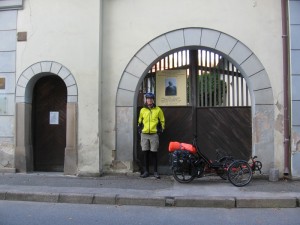
Soon we were on the road again, all paved country lanes with minimal traffic. We were able to decipher a warning in the German guidebook. We could either take a detour using a ferry boat, or go the official route that involves climbing some steep stairs later on. We decided for the ferry, but when we arrived it was not running, and was not scheduled again until the afternoon. Rather than waiting, we opted to push on and try the stairs. These turned out to be stairs up across a pipeline bridge. Kind of an interesting thing to see. After a couple of trips each, we made it up the stairs, across the bridge, and back down the stairs.
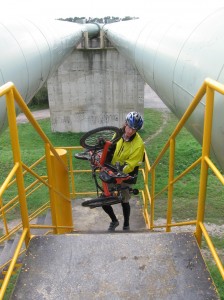
At this point the guidebook indicated that we would be on unpaved trail for a while, which we did not particularly look forward to. We were pleasantly surprised to find ourselves on fresh smooth asphalt. We pedaled along swiftly, looking forward to an early arrival at our destination. Sadly, it was not to be. As we went farther and farther, the condition of the pavement deteriorated into a construction zone. Finally we reached the actual construction crew that was working on paving the trail. One of them mumbled something in Czech which I didn’t understand, and they helped us carry our bikes across the construction area. This is where the track really deteriorated. Before we knew it we were traversing a pile of pure mud kilometers long. We got out and dragged our bikes along, trying to avoid the deepest mud. Dragging a fully loaded touring bike (or trike) through mud is hard work! We finally made it through, after I took my fenders off so the wheels would move again.

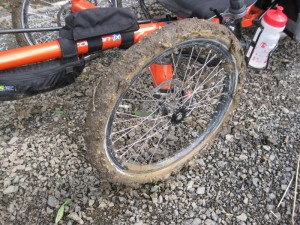

After spending a few minutes cleaning up the bikes as best we could, we started riding again, and I heard a click-click-click sound coming from my left wheel. Not good. Upon closer inspection, it looked like something had gotten lodged in the disc brake and actually bent the spring that keeps the disc off the rotor. If Jennifer hadn’t brought needle-nose pliers on the trip, I might have been riding without one of my brakes. We lost some time with this episode, and our bikes got quite muddy again, but we were finally able to push on.
Back on the pavement again, we got our first view of the pretty town of Melník, which is where the Moldau river merges with the Elbe. We continued along on the paved roads. The Elbe, like the Danube, has many power plants alongside it. The huge complex at Křivenice was impressive, especially since the road passed so close to a huge cooling tower.
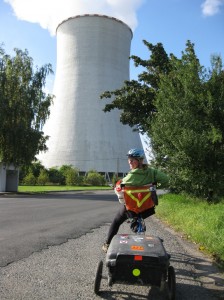
We arrived at Roudnice without further incident, but after looking over the maps we noticed quite a few more unpaved areas. We were not interested in exploring any more unpaved portions of Czech national cycle route 2, so we decided to skip the next section by taking the train to Děčín, which we did the next morning.
The nice and helpful lady at the Information center in Děčín was able to help us book a room in our intended destination town, despite our inability to speak Czech and her inability to speak any of the languages we know. We had noticed that the water level of the river was looking quite high, so we asked the lady to confirm that the cycle route to our destination was passable. She assured us it was, and sent us on our way down the left bank. It was beautiful riding on a smooth track, with wonderful scenery and not crowded at all. In fact, we didn’t see anyone at all. 6km up the trail, we encountered a temporary barrier, and water was creeping up into the trail. We asked a local person there if the trail was passable. He assured us it was not, and we should go back. So, we enjoyed the beautiful scenery and solitude once more, went back to Děčín, crossed the river on a bridge to the right bank, and took the road with the cars. The road wasn’t too busy, and after stopping to observe the flooding a few times (including several km of the trail on the other bank, completely submerged) we arrived at our destination in Hřensko, just short of the German border. Here we will take a day off and do some hiking in the Bohemian Switzerland National Park, then try riding downriver again into Germany towards Dresden.
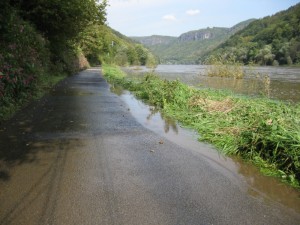
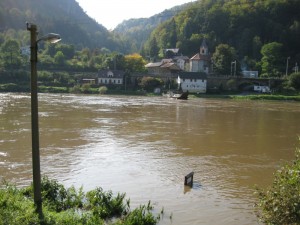
Sounds like the trip has been pretty good, except for the occasional muddy stretch which turn out to be quite horrible. Those stretches, however may be more memorable than much of the rest of the trip.
That could turn out to be the case, indeed… though we have had some very pleasant times, good scenery, interesting museums, etc. that will hopefully also endure as memories. :)
–J.
First off, Happy Birthday Jennifer!
Second, the mud of Europe has always been biblical in nature. I remember trying to march through it when I was in the army.